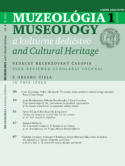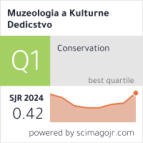

MUZEOLÓGIA
MUSEOLOGY
a kultúrne dedičstvo
and Cultural Heritage

News
Journal Muzeológia a
kultúrne dedičstvo -
Museology and Cultural
Heritage:
SJR 2024: 0,424 (Q1)
Museology SJR rank: 8/83 (Q1) Conservation SJR rank: 11/103 (Q1)JIF WoS 2023: 0,6
JCI WoS 2023: 1,28, Q1 ESCI: 49/411 (Q1)New issue
Muzeológia a kultúrne
dedičstvo 1/2025
online New volume Studia Museologica Slovaca, vol. 8 (2024) online New volume Populačné štúdie Slovenska 17 (2024) onlineNew book
P. Tišliar (ed.). Osobnosti uměleckoprůmyslového muzejnictví (2025). online
Contents 1/2020
Title: The creative drama method in cultural heritage education: Bursa Grand Mosque
Abstract: The research presented here is based on the idea of using creative drama, which adopts the principle of learning by doing
and experiencing, as a method to teach individuals about the artistic and historical elements of religious architecture and increase their
sensitivity to cultural heritage. This particular study involved introducing Bursa Grand Mosque to 9th grade students, with the aim of
raising their awareness of their cultural heritage through processes based on creative drama. The positive feedback from students
showed the project was a success, and the authors propose that similar programmes in other mosques will provide historical and
cultural contributions in terms of forming a connection between yesterday, today and tomorrow, and having a long-lasting, lifelong
impact on the lives of students.
Authors: Kilicaslan Hare, Aktumsek Hulya
Publication order reference: Karadeniz Technical University, Department of Architecture, Trabzon 61080, Turkey, e-mail:
hkkilicaslan@gmail.com; Creative drama instructor, Creative Drama Association, Bursa 16130, Turkey, e-mail:
hulyaakce16@hotmail.com
Source: Muzeológia a kultúrne dedičstvo, year: 2020, vol.: 8, number: 1, pages: 5-17.
Key words: cultural heritage, cultural heritage education, creative drama, Bursa Grand Mosque
online full-text PDF
Title: Expositional design of the Audi museum in Ingolstadt: representation of the brand’s
characteristics in automobile industry history
Abstract: Modern automotive brand museums belong to the corporate museum class; thus, they are versatile in that they perform
multiple tasks. They not only satisfy the visitors’ desire to receive new information, but also realise the business goals of brand
representation, both increasing loyalty to it, and developing corporate culture. The current trend in automotive brand museums’ design
is that the artistic solutions for the exhibition environment form associations among visitors that reflect the personality of a particular
brand. This article analyses the scenario-design organisation of the museum exhibition of the Audi brand, which, during over 100 years
in the automotive market, has formed its unique and inimitable image. Here we reveal the design means of exposition construction,
where the exhibits are integrated into the economic and social conditions of their existence, forming an idea of important milestones in
the history of the twentieth century.
Authors: Bondarenko Iryna, Bondarenko Bohdan, Gonchar Olena
Publication order reference: Kharkiv State Academy of Design and Arts, Faculty of environment design
Ukraine, e-mail: bondirra@gmail.com; e-mail: apokryphos.87@gmail.com; helengo663469@gmail.com
Source: Muzeológia a kultúrne dedičstvo, year: 2020, vol.: 8, number: 1, pages: 19-30.
Key words: museum, car, Audi brand, design, museum exhibition, corporate style
online full-text PDF
Title: History and memory of hospital sites. On the example of the “old” hospital in Topoľčany
Abstract: This paper deals with the site of the old hospital in Topoľčany, which is listed among Slovakia’s national cultural sites. It
combines selected historical and ethnological approaches to the research of the site and its structures with the aim of capturing its
historical and ethnological links and values within an urban environment. The paper is an output of a scientific project featuring the
cooperation of several scientific and research institutions which are active in the technical, social, and human sciences.
Authors: Tišliar Pavol, Kačírek Ľuboš , Janto Juraj
Publication order reference: Comenius University in Bratislava, Faculty of Arts, Department of Ethnology and Museology, Gondova
2, 811 02 Bratislava, Slovakia, e-mail: pavol.tisliar@uniba.sk; lubos.kacirek@uniba.sk; juraj.janto@uniba.sk; Masaryk university,
Faculty of Arts, Department of Archaeology and Museology, Arna Nováka 1, Brno 602 00, Czech Republic, e-mail: tisliar@phil.muni.cz
Source: Muzeológia a kultúrne dedičstvo, year: 2020, vol.: 8, number: 1, pages: 31-45.
Key words: urban history, historical approaches, ethnological approaches, the “old” hospital site in Topoľčany, Slovakia, the
nineteenth and twentieth centuries
online full-text PDF
Title: The Late Gothic Chapel of St Barbara in the Church of the Assumption of the Virgin Mary in
Banská Bystrica
Abstract: The present study maps the history of the Chapel of St Barbara in the Parish Church of the Assumption of Virgin Mary in
Banská Bystrica from several aspects. The first part of study follows the building and historical development of the chapel. In the
second part, the original furnishings of the chapel, of which the altar of Master Paul of Levoča is still preserved, are the focus. The
third and last part focuses on the funds bound to the chapel, through which it is possible to observe the intricate interconnections of
the local burghers’ families. In addition to the aforementioned, the author attempts to look through the history of the chapel into the
wider historical context of the town of Banská Bystrica in that period.
Authors: Mičková Zuzana
Publication order reference: University of Matej Bel in Banská Bystrica, Faculty of Law, Department of History of State and Law,
Komenského 20, 974 01 Banská Bystrica, Slovakia, e-mail: zuzana.mickova@umb.sk
Source: Muzeológia a kultúrne dedičstvo, year: 2020, vol.: 8, number: 1, pages: 47-65
Key words: Banská Bystrica, Church of the Assumption of Virgin Mary in Banská Bystrica, late Gothic, Chapel of St Barbara,
endowment
online full-text PDF
Title: The population of Imereti, Mingrelia, and Guria in the first half
of the nineteenth century: lifestyles and morals
Abstract: This paper examines the lifestyles and morals of certain Georgian tribes in the Northwestern Caucasus. The focus is on
tribes such as the Imeretians, Mingrelians, and Gurians. The authors draw upon a 13-volume work entitled Acta of the Caucasian
Archeographic Commission, as well as a pool of materials from Russian ethnographic expeditions compiled into a work entitled The
Peoples of Russia. The authors conclude by stating that adjoining areas in the western part of the former Georgian kingdom were
home to three Georgian tribes, which were very much alike: the Imeretians, Mingrelians, and Gurians. These tribes formed a sort of
enclave, as many of their national traditions echoed those of their neighbours. Yet each of their traditions also contained features that
were exclusive to one ethnicity alone, making the population of these tribes unique in their lifestyles and customs. Having said that,
the tribes’ neighbours, such as the Abkhaz, Circassians, and Khevsurs, had lifestyles and customs that were similarly typical of their
specific particular ethnicities alone.
Authors: Ivantsov Vladimir, Cherkasov Aleksandr, Bratanovskii Sergei, Koroleva Larisa
Publication order reference: Sochi State University, 94 Plastynskaya str., 354003 Sochi, Russian Federation; International Network
Center for Fundamental and Applied Research, 1150 Connecticut Ave. NW, 20036 Washington D.C., USA, Volgograd State University,
100 Yniversitetskii prospekt, 400062 Volgograd, Russian Federation, e-mail: sochi003@rambler.ru; Plekhanov Russian University of
Economics, 36 Stremyannyii pereylok, 117997 Moscow, Russian Federation, Institute of State and Law of RAS, 10 Znamenka str.,
119019 Moscow, Russian Federation, e-mail: bratfoot@mail.ru; Penza State University of Architecture and Construction, 28 Germana
Titova str., 440028 Penza, Russian Federation, e-mail: la-koro@yandex.ru
Source: Muzeológia a kultúrne dedičstvo, year: 2020, vol.: 8, number: 1, pages: 67-77.
Key words: Imeretia, Mingrelia, Guria, population, first half of the nineteenth century, traditions
online full-text PDF
In Practice
Title: The restoration/conservation in Georgia: past, present, future
Abstract: From the end of the 1990s, an issue relating to methodological problems of protection and conservation of specimens of
cultural heritage became especially acute in Georgia. At the same time, various kinds of mistakes were observed in restoration and
repair works conducted on movable and immovable monuments. Due to recognition of this urgent problem, at the end of 2004, the
Rector of Tbilisi Academy of Art initiated the establishment of a Faculty of Restoration, Art History and Theory in the State Academy of
Arts of Tbilisi, the aim of which was to establish a scientific basis on which to conduct the conservation-restoration of specimens of
cultural heritage, and many steps were taken in this direction.
Authors: Kuprashvili Nana, Mikaberidze Lela, Dzigua Natia, Bugadze Nino, Meliva Tamara
Publication order reference: A. Kutateladze Tbilisi State Academy of Arts, 22 Griboedovst. 0108, Tbilisi, Georgia, e-mail:
nana.Kuprashvili@art.edu.ge, e-mail: lelamikaberidze@yahoo.com, e-mail: ndzigua@yahoo.com, e-mail: tamarameliva@gmail.com
Source: Muzeológia a kultúrne dedičstvo, year: 2020, vol.: 8, number: 1, pages: 79-83.
Key words: cultural heritage, conservation, development, teaching, Georgia
online full-text PDF
Books received and reviews
Zdena Krišková: Konferencia „Múzeá v prírode – koncepcie, realita a vízie“,
15.- 16. mája 2019 vo Vychylovke (p. 84) online full-text PDF
Articles (Abstracts)

Full-text version

eISSN 2453-9759
Vol. 8 (2020), No. Is. 1


























